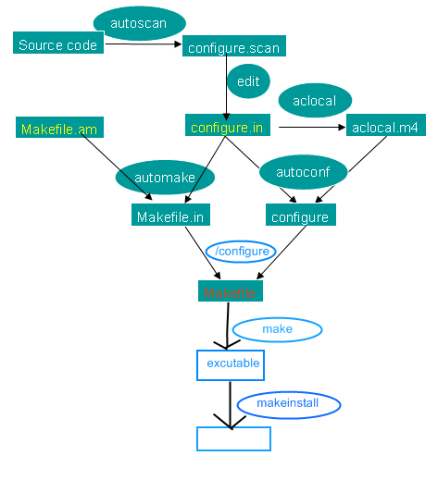一 过程

二 脚本
EXIT_VALUE = 0
# setp1
autoscan
STATUS =$ ?
if [ $ STATUS -ne 0 ] ; then
EXIT_VALUE = 1
echo autoscan FAILED
exit $ EXIT_VALUE
fi
# step2
rename configure . scan configure . in configure . scan
STATUS =$ ?
if [ $ STATUS -ne 0 ] ; then
EXIT_VALUE = 1
echo autoscan FAILED
exit $ EXIT_VALUE
fi
# step3
rm -f configure
find . -name " *.cache " -exec rm -rf {} \;
libtoolize --force
STATUS =$ ?
if [ $ STATUS -ne 0 ] ; then
EXIT_VALUE = 1
echo libtoolize FAILED
exit $ EXIT_VALUE
fi
# step4
aclocal
STATUS =$ ?
if [ $ STATUS -ne 0 ] ; then
EXIT_VALUE = 1
echo aclocal FAILED
exit $ EXIT_VALUE
fi
# step5
automake
STATUS =$ ?
if [ $ STATUS -ne 0 ] ; then
EXIT_VALUE = 1
echo automake FAILED
exit $ EXIT_VALUE
fi
# step6
autoconf -f
STATUS =$ ?
if [ $ STATUS -ne 0 ] ; then
EXIT_VALUE = 1
echo autoconf FAILED
exit $ EXIT_VALUE
fi
# step7
./ configure --enable-optimized = yes
STATUS =$ ?
if [ $ STATUS -ne 0 ] ; then
EXIT_VALUE = 1
echo configure FAILED
exit $ EXIT_VALUE
fi
# step7
make -j 4
STATUS =$ ?
if [ $ STATUS -ne 0 ] ; then
EXIT_VALUE = 1
echo make FAILED
exit $ EXIT_VALUE
fi
# step8
make -j 4 install
STATUS =$ ?
if [ $ STATUS -ne 0 ] ; then
EXIT_VALUE = 1
echo make install FAILED
exit $ EXIT_VALUE
fi
exit $ EXIT_VALUE
三 参考
http://www.cnblogs.com/itech/archive/2009/05/25/1488983.html
完!






 本文详细介绍了自动化编译安装的过程,包括使用autoscan、rename、libtoolize等工具进行源码准备,通过aclocal、automake、autoconf生成构建文件,并最终完成configure、make及make install步骤。
本文详细介绍了自动化编译安装的过程,包括使用autoscan、rename、libtoolize等工具进行源码准备,通过aclocal、automake、autoconf生成构建文件,并最终完成configure、make及make install步骤。

















 267
267

 被折叠的 条评论
为什么被折叠?
被折叠的 条评论
为什么被折叠?








